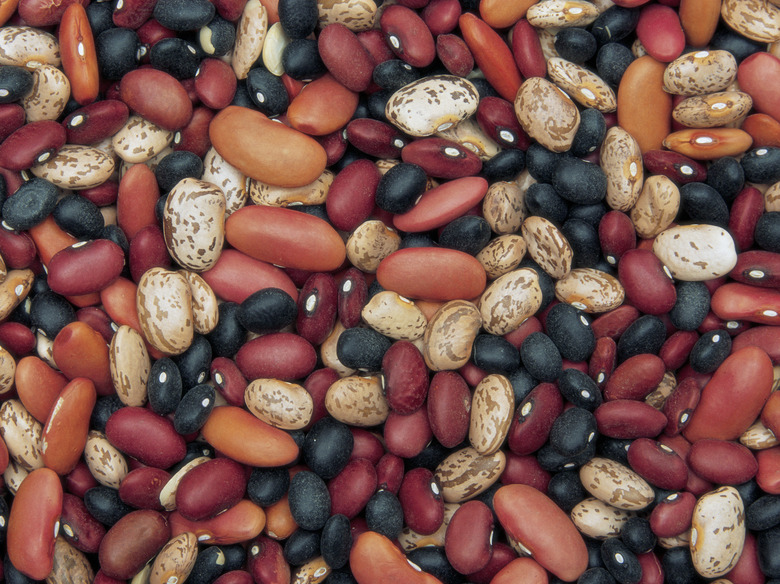Science Fair Projects About Growing Beans And The Life Cycle
Beans are the perfect medium for demonstrating a plant's life cycle for a science project as they grow fast, are relatively hearty and require little maintenance. Whether you want to compare various beans varieties, stages of growth or growing conditions, beans will do the trick. Bean experiments can be incorporated for science projects for children at the kindergarten level up through the elementary grades.
Different Soils
Different Soils
You can test to see how fast beans grow in different soils. Collect at least three or four different types of soil materials from various locations for this experiment. A mixture of gravel, small rocks and sand should be one of your soil samples and can be found by rivers or fast-moving water sources. Clay or silt should be included in this experiment and can be found near a lake. Use potting soil from the store or topsoil from around your home as your control soil. Measure out the same amount of soil in cups or planting pots. Plant the bean seeds in the same manner for each pot and water the same amount for each. Measure and record your beans' grown at least once a week for a month or two. Compare your results.
Different Water Amounts
Different Water Amounts
Since water is one of the vital parts of the plant growing process, you can experiment with the ideal amount of water for optimal growth. You will need to work with three beans of the same variety for this. One should get the ideal amount of water, one should get more and one should get little water. The National Gardening Association recommends watering beans deeply and gently instead of light, frequent waterings. For plant No. 1, moisten the whole cup of soil with water, but don't make a dirt soup. Water this plant when the soil is dry on top and when the plant looks wilted in the morning. For plant two, lightly mist the plant and soil with water whenever you water plant No. 1. For plant three, water the plant every two or three days. Document the days you water each plant and the amount of water each gets.
Different Beans
Different Beans
Bean varieties grow in the same basic fashion, but you can observe and compare different bean varieties throughout the life cycle to see if there are any noticeable differences among them. Choose three or more different bean types, such as peas, lima beans and kidney beans. Grab a resealable plastic bag and a moist paper towel for each bean. For each bean, fold a paper towel into square quarters, place a bean in the inner fold, gentle place the paper towel and bean in the bag and seal the bag. Label each bag and tape them to a window that receives adequate sunlight. Once every two or three days, gently take the bag down, unfold the paper towel and observe the beans. Measure the length of the beans and make a drawing of each. Write down any observable changes before putting the beans back in the bag. A root shoot will pop out of each bean and continue to grow. The root will start to sprout some hairlike roots. Eventually a stem will appear on the plant and it will grow some leaves.
Life Cycle Stages
Life Cycle Stages
Comparing plants that are at different stages of the life cycle can be a useful means to demonstrate how the plant grows and changes above ground over time. Collect four to eight bean seeds of the same bean variety. The number of beans depends on how long you want to run your experiment — you will need one bean for each week. Grab one Styrofoam cup for each of your seeds. On day one, fill the cup with potting soil and plant one bean seed in it. On day eight, plant another seed in the same fashion. Continue planting one new seed every week. Water the bean plants the when the soil looks dry and the plants starts to wilt slightly. At the end of four to eight weeks compare the size and structure of all of your plants.
Cite This Article
MLA
Revermann, Susan. "Science Fair Projects About Growing Beans And The Life Cycle" sciencing.com, https://www.sciencing.com/science-fair-projects-growing-beans-life-cycle-12291429/. 24 April 2017.
APA
Revermann, Susan. (2017, April 24). Science Fair Projects About Growing Beans And The Life Cycle. sciencing.com. Retrieved from https://www.sciencing.com/science-fair-projects-growing-beans-life-cycle-12291429/
Chicago
Revermann, Susan. Science Fair Projects About Growing Beans And The Life Cycle last modified August 30, 2022. https://www.sciencing.com/science-fair-projects-growing-beans-life-cycle-12291429/
